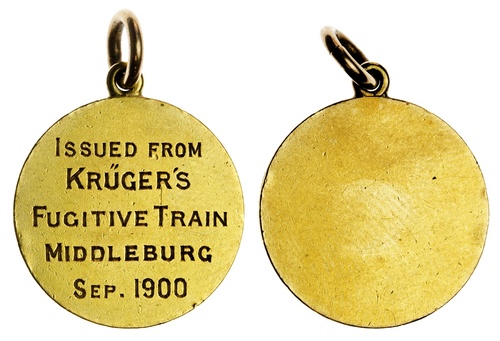Paul Kruger, the Extremely Rare and Desirable Complete 1892 Proof set, comprising gold Pond with double shaft to ox-wagon, gold Half-Pond, silver Crown with double shaft to ox-wagon, Halfcrown, Florin, Shilling, Sixpence and Threepence, bronze Penny (Hern 1) [9]. A superb set, all with matching or similar grades and tones, about as struck, of the highest rarity; housed in three purpose-made mahogany fitted and lined cabinets (£50,000-60,000) Footnote Although a lease had been granted in 1891 to the Nationale Bank of the Zuid Afrikaansche Republiek to establish a state mint in Pretoria, President Kruger was anxious to get new coins into circulation and placed an order with the Royal Prussian mint at Berlin. The task of engraving the dies was assigned to Otto Schultz (1848-1911), the Berliner who had enjoyed a varied career working with the Loos medallic business in the city and with L.C. Wyon at the Royal Mint, London, before joining the Berlin mint as Second Medallist under Emil Weigand (1837-1906). Initially Schultz engraved the ox-wagon on the three largest denominations with two shafts, instead of the single shaft of the disselboom [wagon with a single pole] represented in the arms of the Republic. This, and the fact that Schultz placed his initials below the bust of Kruger, which were interpreted in Afrikaans as ox, meant that the first shipment of coins from Berlin were ill-received in the Republic. On Kruger’s orders the dies were altered and it was not until 1893 that the new Pretoria mint started striking 1892-dated coins from Berlin-prepared dies. It is estimated that less than 10 complete 1892 proof sets exist and the Berlin mint, where they were struck, did not issue them in cases, which accounts for the fact that some of the coins exhibit minor surface blemishes. All the coins in this set have been slabbed with the following grades, Pond (NGC PF 63), Half-Pond (PCGS PR 62), Crown (NGC PF 63), Halfcrown (PCGS PR 62), Florin (PCGS PR 63), Shilling (PCGS PR 64), Sixpence (PCGS PR 64), Threepence (PCGS PR 64), Penny (PCGS PR 64BN)
Paul Kruger, the Extremely Rare and Desirable Complete 1892 Proof set, comprising gold Pond with double shaft to ox-wagon, gold Half-Pond, silver Crown with double shaft to ox-wagon, Halfcrown, Florin, Shilling, Sixpence and Threepence, bronze Penny (Hern 1) [9]. A superb set, all with matching or similar grades and tones, about as struck, of the highest rarity; housed in three purpose-made mahogany fitted and lined cabinets (£50,000-60,000) Footnote Although a lease had been granted in 1891 to the Nationale Bank of the Zuid Afrikaansche Republiek to establish a state mint in Pretoria, President Kruger was anxious to get new coins into circulation and placed an order with the Royal Prussian mint at Berlin. The task of engraving the dies was assigned to Otto Schultz (1848-1911), the Berliner who had enjoyed a varied career working with the Loos medallic business in the city and with L.C. Wyon at the Royal Mint, London, before joining the Berlin mint as Second Medallist under Emil Weigand (1837-1906). Initially Schultz engraved the ox-wagon on the three largest denominations with two shafts, instead of the single shaft of the disselboom [wagon with a single pole] represented in the arms of the Republic. This, and the fact that Schultz placed his initials below the bust of Kruger, which were interpreted in Afrikaans as ox, meant that the first shipment of coins from Berlin were ill-received in the Republic. On Kruger’s orders the dies were altered and it was not until 1893 that the new Pretoria mint started striking 1892-dated coins from Berlin-prepared dies. It is estimated that less than 10 complete 1892 proof sets exist and the Berlin mint, where they were struck, did not issue them in cases, which accounts for the fact that some of the coins exhibit minor surface blemishes. All the coins in this set have been slabbed with the following grades, Pond (NGC PF 63), Half-Pond (PCGS PR 62), Crown (NGC PF 63), Halfcrown (PCGS PR 62), Florin (PCGS PR 63), Shilling (PCGS PR 64), Sixpence (PCGS PR 64), Threepence (PCGS PR 64), Penny (PCGS PR 64BN)
/79442/Photo1%20data.jpg)


/116097/Photo1%20data.jpg)


/180731/Photo1%20data.jpg)
/94934/Photo1%20data.jpg)
/70704/Photo1%20data.jpg)
/61509/Photo1%20data.jpg)
/61997/Photo3%20data.jpg)

/138023/Photo1%20data.jpg)


Try LotSearch and its premium features for 7 days - without any costs!
Be notified automatically about new items in upcoming auctions.
Create an alert